If there is one thing we all want when embarking on a fishing mission, it is success. Whether you want to bring home a few fish for dinner, catch and release a trophy or just want to have a fun day out fishing with the kids, catching fish is what we all love to do. And with one simple little addition to your fishing session, you can turn a dull day into mayhem in just a few minutes – with berley.
Of all the more commonly targeted species in Victoria, many are schooling fish, which means when you begin to attract them you tend to attract a school. For anyone wanting to just catch a fish, using berley will surely make it happen. In saying that, berleying isn’t as simple as tossing out handfuls of fish offal within a few minutes of getting to a location followed by nothing for the following four hour long session; rather there is more of an art to berleying successfully than many might think.
Not all berley methods and ingredients are used on all of the same species. Different species swim and feed in different columns of the water and providing you understand your targeted species, adding berley to the equation will enhance success.
In this two part series, I will be looking at the different berley techniques for popular species: snapper, whiting, sharks, garfish, Australian salmon and yellow-eye mullet.
Snapper are a species that falls into the ‘schooling fish’ category and are quite easily attracted with berley. Anglers fishing in Western Port tend not to berley for snapper due to the force of the current and the fact that stingrays can be attracted. Despite the current, a little berley at the right times can be very effective.
Around 30 minutes either side of a tide change is the prime time to berley so it sinks to the bottom. To do this, berley can be in the form of pilchard cubes and snapper pellets tossed over the transom and left to float down to the bottom.
Another more highly effective berleying method is to use a Secret Weapon berley dispenser. The Secret Weapon can be filled, lowered to the bottom and emptied multiple times before the tide kicks in. Then as the boat swings with the tide, the berley will begin to flow along the bottom thus attracting the fish to the area.
This technique can also be applied to Southern Port Phillip Bay from Sorrento to Mount Martha where there is also substantial current.
From Mount Martha to the top of the bay, different methods are more productive. Due to the lack of current, small cubes of pilchard coupled with a few handfuls of snapper pellets tossed out at equal intervals is the most effective berleying technique possible. The only downfall to this technique is that you’re manually berleying.
Unfortunately when manually berleying, you can forget to toss in more berley breaking the trail. When this happens, the fish can go off the bite and, until you work out the berley trail has been broken for a period of time, they might have swam off or gone to the next boat’s trail. The only way to ensure you don’t break the trail is have a continual pile of chopped pilchards on the bait board to twig your memory if you do forget.
Whiting are a species that are easily targeted with the use of berley but a lot of anglers still enjoy the ‘old’ fishing technique of anchoring, fishing for 10 minutes then moving some 30 minutes before repeating the process to find a school of fish. When fishing in shallow water, the noise from boat motors being started and switched off, anchor chains rattling when being lifted and lowered is enough to scare any fish from the area. Berley on the other hand can be a real game changer without having to move, rather it will bring the fish right to you.
With more and more anglers searching out whiting in both deep water and shallow water, berley can be used in both locations. Berley methods for whiting aren’t too complex but it is imperative that the right berley cage be used so the flow stays constant.
Once filled with the chosen berley mix, place the pot on the sea floor and the current’s pressure will disperse the berley keeping a constant flow while the whiting move in on the trail.
Every now and then, a shake of the pot is required as the holes in the pot will block up. When this happens, you’ll notice the whiting bite go quiet but with a little shake, they will return once the flow starts again.
Offshore shark fishing is becoming increasingly popular, and why not so when they are so easily accessible in our waters. Although we do have a wide range of sharks on offer, mako sharks are the most commonly targeted.
One of the biggest assets to mako fishing is the use of berley but it is imperative you have enough. Most offshore shark fishing missions generally go for around 6-8 hours and berleying for this length of time does take its toll.
Like any berley used for any fish, the fishier the better and, while I have heard of many weird concoctions being made and used, nothing can beat berleying with tuna. Most tackle stores will sell frozen tuna logs but those that fish at Portland during tuna season can always bring some back with them and mince it up into small logs until their shark session.
Although tuna logs are great, you’ll also need something a little chunkier, which is where pilchards or any old fish offal punched through the berley pot works a treat. Coupled with that, a tuna oil bottle hung over the side of the boat with a few holes in it to create a slick finishes off the entire setup. Again, this is one species you do not want to break a trail with so ensure whoever is on berley duty, does a top job.
While you have the pilchards being put through, have two logs each in a scaler bag on either side of the boat. With any wave action, the logs will scrape on the bag and dislodge chunks keeping the trail consistent.
Baits can then be set back into the trail at different levels of the water column while the waiting game begins.
There are endless ways you can use berley and endless ingredients that can be used in it. All it takes is a little imagination, the right mix, flow and location and you’ll very quickly see the results unfold.
Next week in Part 2 we will take a look at three more species, garfish, Australian salmon and yellow-eye mullet and how to attract them to your fishing area.
5 RULES OF ATTRACTANT
1. When using berley keep the mix as fine as possible based on the species.
2. Always keep the berley trail at a constant flow.
3. Make the berley as fishy as possible.
4. Ensure you have enough berley for your session.
5. Never break a berley trail.
SNAPPER BERLEY MIX (Western Port/PPB south)
1 x 2kg bag of pilchards
1 x 1kg bag of snapper pellets
Cut pilchards into 1cm cubes, fill Secret Weapon berley dispenser with mix, wait for slack tide and dump all pilchards and pellets behind boat before tide picks up.
SNAPPER BERLEY MIX (Port Phillip Bay north)
1 x 4-6kg bag of pilchards
1 x 4kg bag of snapper pellets
Cut pilchards into 1cm cubes (5 pilchards at a time), toss overboard with a handful or two of pellets every 5 minutes until fish are going, then lessen the flow of berley by tossing in same amount every 8-10 minutes.
WHITING BERLEY MIX
1 x 2kg bag of Whiting berley pellets (tuna oil infused)
1 x 1kg bag of pilchards
1 x 500ml bottle of tuna oil
Mix all ingredients together over night in a bucket mashing the pilchards up. Half fill berley pot when fishing and place on seafloor. Ensure berley bucket is weighted so it sits directly under the boat, not on an acute angle due to the current pressure.
Reads: 2698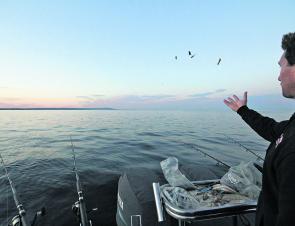
Berleying for snapper is very simple provided you can keep the trail going. Pilchards cut into 1cm cubes are ideal in Port Phillip Bay.
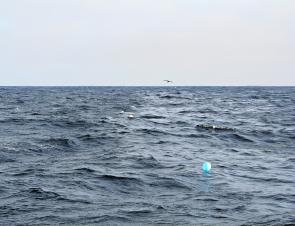
Once a berley trail is created, it is easily identified by the surface slick.
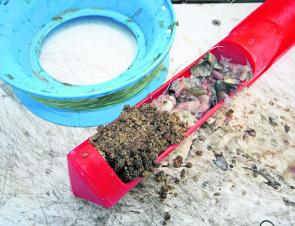
When attempting to berley in Western Port, use a Secret Weapon Berley dispenser. Load it with pellets and chopped pilchards and lower to the bottom.

The Secret Weapon berley dispenser is weighted and will easily reach the bottom nearing the slack tide. Once on the bottom, give a little tug to dispel the berley.

Stainless steel berley cages are ideal for when the tide is running. Whether you’re fishing on the shallow banks for whiting or in the deep for snapper, they suit perfectly.
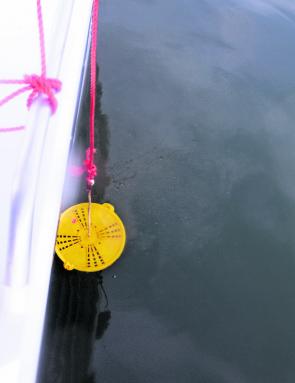
Berley pots with small holes work very well for garfish and whiting. Berleying from the surface is a good technique as the current will keep the berley flowing attracting garfish, salmon and trevally from vast distances.

When embarking on a shark mission, specially made shark berley logs are a great idea.
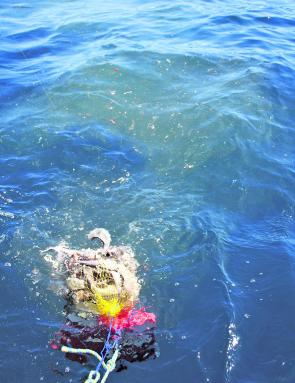
Onion bags and scaler bags are ideal to hold shark berley logs. The wave action breaks up the logs dispersing a smelly continuous trail.
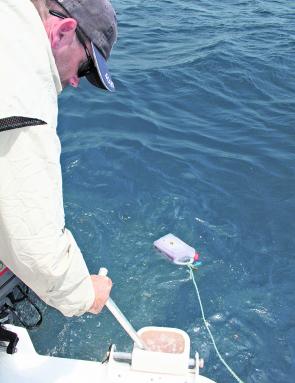
Even with shark logs in bags, someone must still punch the berley so heavier chunks of berley flow down the trail making it a wall of berley.
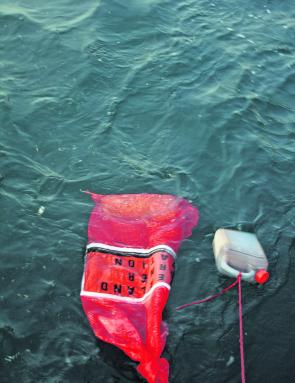
A tuna oil bottle tied off to a cleat with some holes punched in it creates a surface slick which also adds to the fishy smell.




